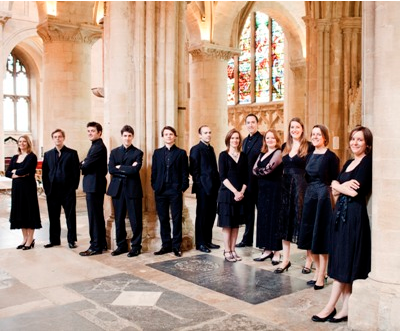As one of the 20th century’s most beloved composers, Benjamin Britten stands out for his outstanding choral offerings. Born in 1913, the English composer left a legacy of vocal repertoire that continues to inspire to this day. In celebration of the Britten Centenary, the singers of Seattle Pro Musica have dedicated their annual holiday program the composer’s Christmas-themed choral works, including yuletide favorite A Ceremony of Carols.
The concert pairs Britten classics with lesser-known gems by contemporary composers, making for an appealing blend of new and old that’s bound to delight fans of choral music. Festivities began with two performances at Town Hall on December 7 and continue with two more on December 14 at the Bastyr University Chapel. The program focuses on Britten’s fascination with historical texts, from 15th century British carols to 19th century poetry. Throughout his career, Britten drew upon older pieces of writing as compositional sources, passing on his penchant for combining ancient text with new music to many of today’s choral composers.
Directed by Karen P. Thomas, the 80-member Seattle Pro Musica continues to charm audiences with their annual Christmas concert, which has become a local holiday tradition. This year’s Britten celebration follows on the heels of other Seattle Pro Musica events commemorating the 100th anniversary of the composer’s birth, including a performance of the massive War Requiem in June alongside the Seattle Symphony and Chorale.
December 7th’s afternoon concert began with a candlelight procession performed by the women of the choir. The ensemble filed through the auditorium and onto the Town Hall stage while singing a medieval English Christmas chant, “A solis ortus cardine”. This opening provided a meditative counterpoint to the more energetic works ahead, while also paying tribute to the ancient chants and texts that inspired Britten and others.
Two suites of yuletide carols by Britten anchored the program, one written during the composer’s youth and the other as he was reaching artistic maturity. Composed when Britten was just 19, A Boy was Born demonstrates the budding composition student’s gift for creating complex vocal textures and using musical effects to “illustrate” words or phrases. The suite of seven carols follows a theme and variations format that explores a variety of musical moods, from the ethereal opening chorale to the victorious fanfare of the sixth and final variation, “Noel”. Thomas and the choir expertly navigated the sudden transitions between variations, which often flowed from one to another through a connecting syllable or note.
The combination of Britten’s descriptive writing and Seattle Pro Musica’s vocal versatility resulted in many magical moments during A Boy was Born’s seven movements. In the fifth variation, “In the Bleak Mid-winter”, soprano Chrissie Graham’s lush voice soared overhead in a mournful allegory of Jesus’ death. Her solo was accompanied by soft chants of the phrase “snow on snow” from the choir, transporting me to a winter landscape framed by the steady fall of snowflakes.
Premiered in 1942, Britten’s A Ceremony of Carols is full of similarly rich sonic illustrations and layered harmonies. Like A Boy was Born, A Ceremony of Carols demonstrates Britten’s penchant for all things old, especially his love for historic English poetry and chant. The work begins with a processional strikingly similar to the medieval chant that opened the concert and quickly departs on a whirlwind tour of musical expression.
Nuanced accompaniment by harpist Catherine Barrett blended well with the choir in both solo and ensemble sections. Particularly moving was the brief third movement, “That younge childe”, which featured Barrett and soprano Amanda Jessup echoing each other on a melody full of sorrowful sighs. Barrett’s playing evoked a variety of imagery throughout the work, from a rocking cradle to the biting winter wind. With this foundation, the women of Seattle Pro Musica filled in the rest of the musical story. Dramatic movements like “This little Babe” showcased the choir at its best, weaving together overlapping melodies with an ease that left me enraptured.
A surprise hit of the concert was the choir’s performance of Conrad Susa’s Carols and Lullabies: Christmas in the Southwest. Susa, who just passed away in November, wrote the piece as a companion to A Ceremony of Carols. Based on Spanish and Latin-American carols, the colorful choral suite adds guitar and marimba along with harp accompaniment. Guitarist Michael Partington and percussionist Timothy Helming brought just the right amount of Latin flavor to the suite’s ten movements.
Though the traditional Spanish tunes in Carols and Lullabies probably aren’t familiar to most American audience members, their celebratory spirit and catchy melodies give them instant appeal. The carol “Alegría” begs for a sing-along, especially given Susa’s arrangement. Baritones Jeff Myers, Jon Repp, and Lee Maneman lustily belted out the verses, then were joined by the full choir for the refrain. Other movements featured more complex harmonies influenced by Spanish folk songs and dances. With its tongue-twisting title and guitar-tinged refrain, “Chiquirriquitín” provided lots of folksy fun for both audience and choir.
Like Britten’s A Ceremony of Carols, Susa’s Carols and Lullabies is full of solos, duets, instrumental interludes, and opportunities for the entire ensemble to shine. Full of vivid colors, Seattle Pro Musica’s performance swept me away from the Seattle chill to a boisterous Latin-American Christmas celebration in warmer climes. The final carol in Susa’s suite captures the work’s exuberance, complete with emphatic strums on the guitar to emphasize the cries of “Fum! Fum! Fum!” in the refrain. Like much of the piece, it has an infectious melody which stuck with me long after the concert ended, leaving me hoping that Susa’s work will be performed more regularly.
Several Christmas-themed works by contemporary composers may have received their Seattle premiere at the December 7 performance, including Bernard Hughes’ “The Shepherd’s Carol” and Gabriel Jackson’s “The Christ-child”. Originally commissioned by the Seattle Men’s Chorus, Alice Parker’s romp Roll round with the year brought a bit of jolly good fun to round out the program.
